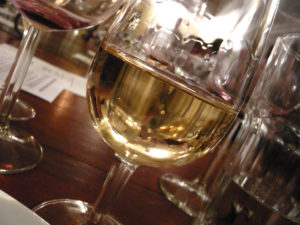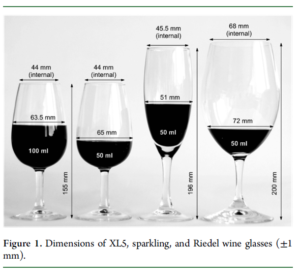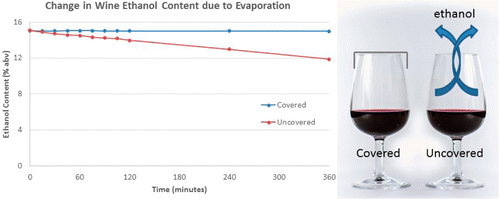It is a simple matter of physics that when you have a liquid exposed to air, there is going to be some evaporation of sorts. A glass of water will eventually evaporate over a long period of time if it’s left someplace out in the open. With wine, which is a mixture of water, alcohol, and a bunch of other stuff, the same phenomena applies, though the alcohol and water will likely evaporate at different rates due to the physical properties of each compound. Just how much alcohol evaporates from a glass of wine sitting on the table? And is it even enough to notice any difference as you drink it?

Photo courtesy Flickr user Jessica Spengler
While this concept is just a matter of basic physics, there really hasn’t been very much research on the subject in the peer-review arena. Studies have shown that the thin film of wine that can be seen along the sides of a wine glass (“wine tears”) is the result of the evaporation of alcohol (also known as the “Marangoni effect”), though these studies never specifically measured the level of alcohol remaining in the glass to see if any noticeable changes occurred.
Additionally, it is known that the alcohol content of a wine can significantly affect the aromatics of a wine (as well as other sensory characteristics), with specific alcohol levels known to some winemakers as the “sweet spot” result in the best balance, and any deviation outside of that sweet spot results in decreased sensory quality.
A study published in September 2016 in the Journal of Agricultural and Food Chemistry, aimed to examine this phenomenon further, by measuring the changes in alcohol content in a wine glass over time, and to determine if these changes had any effect on the sensory characteristics of that wine or not.
Brief Methods
This study employed three separate trials:
Trial 1
A 2014 Cabernet Sauvignon was placed in ISO Standard XL5 wine glasses at a volume of 50mL/glass.
Three separate treatments were applied:
- The glass was covered with plastic lids.
- The glass remained uncovered and was placed on a lab bench with minimal airflow (<5L/s).
- The glass remained uncovered and was exposed to continual airflow (30.5L/s).
Ethanol content, wine density, and changes in mass were monitored at 15 minute intervals between 0 and 120 minutes, then also at 240 minutes and 360 minutes after the trial began.
Trial 2
2 white table wines, 2 red table wines, and 2 fortified wines were placed in ISO Standard XL5 wine glasses at a volume of 50mL/glass.
The same treatment conditions as was performed in Trial 1 were repeated in Trial 2.
Ethanol content, wine density, and changes in mass were monitored at the beginning of the trial, and then again 120 minutes later.

Reprinted (adapted) with permission from Wollan, D., Pham, D-T., and Wilkinson, K.L. 2016. Changes in Wine Ethanol Content Due to Evaporation from Wine Glasses and Implications for Sensory Analysis. Journal of Agricultural and Food Chemistry 64: 7569-7575. Copyright 2016 American Chemical Society.
Trial 3
In this trial, glass type and volume of wine was examined.
The 2014 Cabernet Sauvignon (the same as was used in Trial 1) was placed into three different types of glasses:
- The ISO Standard XL5
- A sparkling wine flute
- A Riedel Ouverture Magnum
The treatments were the same as in Trials 1 and 2, though for Trial 3, and additional glass of 100mL (in the ISO Standard XL5 glass) was included.
Ethanol content, wine density, and changes in mass were monitored at the beginning of the trial, and then again 120 minutes later.
Wine glass height, surface area of wine, and diameter of the glass opening were measured.
Sensory Analysis
A panel of 18 judges was utilized for the sensory analysis portion of this study.
The wines used were from Trial 1 at the 120 minute mark.
Wines were presented to the judges in covered glasses and in random order. The judges were asked simply to smell the wines and determine which one(s) were different (if they differed at all).
Other Analyses
Volatile compounds (including esters and alcohols) in the wines were measured and analyzed using gas chromatography-mass spectroscopy.
Selected Results
Trial 1
- No changes in ethanol content, density, or mass were found in wines that were covered.
- With uncovered wines, significant differences in ethanol content were noted within 15 minutes of the trial start.
- After 6 hours, the wine exposed to minimal airflow lost 1% alcohol by volume (abv), had a slight increase in density, and lost close to 1g of mass.
- After 6 hours, the wine exposed to a steady flow of air lost 3.2% abv, had an increase in density, and lost close to 3.5g of mass.
Trial 2
- Results from Trial 2 were pretty much the same as they were in Trial 1.
- The wine with the highest alcohol content (the Muscat fortified wine) saw the biggest loss in abv over the duration of the trial.
- Initial alcohol content did not seem to influence how much alcohol was lost over the course of the 2 hour trial.
Trial 3
- As with both Trial 1 and Trial 2, covered wines saw no changes in ethanol content, while uncovered wines differed significantly.
- The larger Riedel Ouverture Magnum glasses saw the greatest loss of abv.
- Headspace volume was strongly correlated with alcohol loss.
- Taking the above two results, while the larger opening of the glass affected abv loss, the volume of wine inside the glass also influenced this loss, thereby glass size alone isn’t the only player here.
Sensory & Chemical Analyses
- 13 of the 18 judges were able to identify the glass with the lower alcohol content.
- 11 out of 15 volatile compounds analyzed were found to be significantly lower in the uncovered wines exposed to steady airflow.
- Losses observed included:
- 64% for ethyl octanoate.
- 100% for 2-methylpropyl acetate and hexyl acetate (the researchers noted these two were already quite low to begin with).
- 21% for hexanol.
- 38% for ethyl decanoate.
- <10% for 2-phenyl ethanol.
- <10% for 2-phenylacetate.
- Losses observed included:
Conclusions
Overall, the results showed that some of the alcohol in a glass of wine will evaporate in as early as 15 minutes after being set out and exposed to airflow, though it took up to 2 hours for the alcohol to drop 1% in those wines exposed to the greatest airflow. After 2 hours, most of the judges were able to pick out the wine that had been sitting out. After 6 hours, alcohol levels in the wines dropped upwards of 3.2%abv.
For every day consumers, I imagine most aren’t milking a single glass of wine over the course of 2 to 6 hours, so they are probably drinking it fast enough such that the small drop in abv would be left unnoticed. That being said, since the study only did the sensory analysis at the

Reprinted (adapted) with permission from Wollan, D., Pham, D-T., and Wilkinson, K.L. 2016. Changes in Wine Ethanol Content Due to Evaporation from Wine Glasses and Implications for Sensory Analysis. Journal of Agricultural and Food Chemistry 64: 7569-7575. Copyright 2016 American Chemical Society.
2 hour mark, I can’t be completely certain that someone couldn’t tell the difference at an earlier time point. Having the judges sample the wines at the earlier time point would paint a clearer picture on the subject.
Where the results of this study do come in to play, however, is in the situation where you have a major judging event, such as a wine competition or some other event where there is the possibility of glasses of wine being left out for a longer period. Some wine competitions have strict protocols where they keep the wine glasses covered after they have been poured, but for those competitions that don’t employ this practice, there is a change that final results of the competition could be affected due to significant sensory changes of some of the wines that have been sitting out for a while.
With many competitions or other professional tastings, efforts are often made to try and limit the number of wines a single judge is responsible for evaluating, however, that sometimes can’t happen for logistical purposes, and a single judge ends up having to taste a significant number of wines that take up a longer chunk of time. If the wines are poured into glasses and not subsequently covered, the results of this study would indicate that the alcohol content as well as the aromatic volatile components of the wine would change, leading to decreased quality of the wine in the glass and therefore not representative of the wine that was entered into the competition or tasting.
It should also be noted that the size/shape of the wine glass appeared to affect the alcohol/volatile content of the wine, with larger openings leading to greater evaporation (and thereby greater volatile loss) over time. This result could also be important for wine judging, particularly again if a wine is going to be setting out for a long period of time.
Of course, the results of this study would suggest that all you have to do is put a cover on the wine glass to avoid any of these changes in the chemical and sensory characteristics of the wine, so theoretically you can use whatever glasses you want and let the wines sit out for as long as you want (until a point, I’m sure…) and the wine will be the same as it was when it was first poured.
Source:
